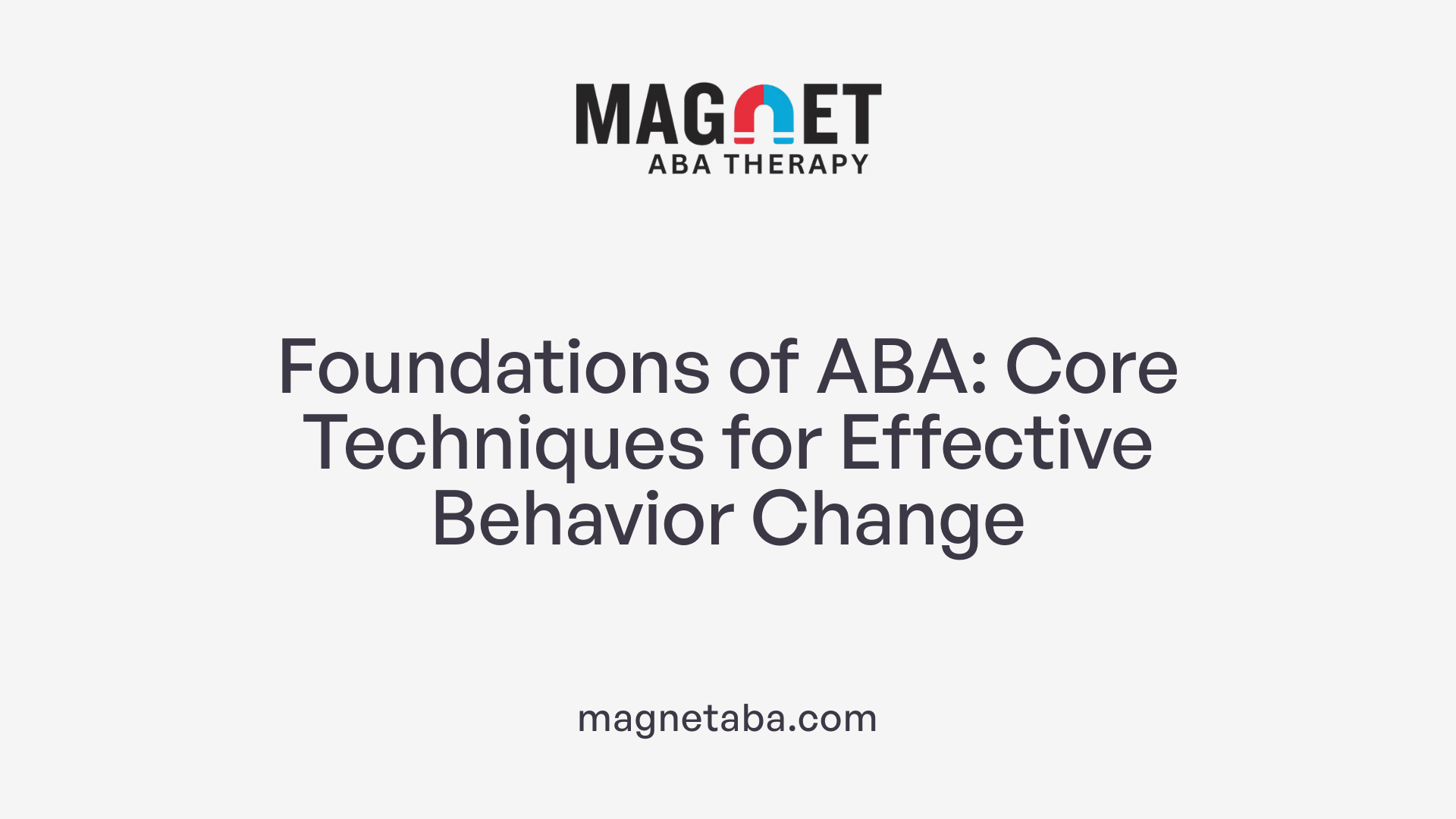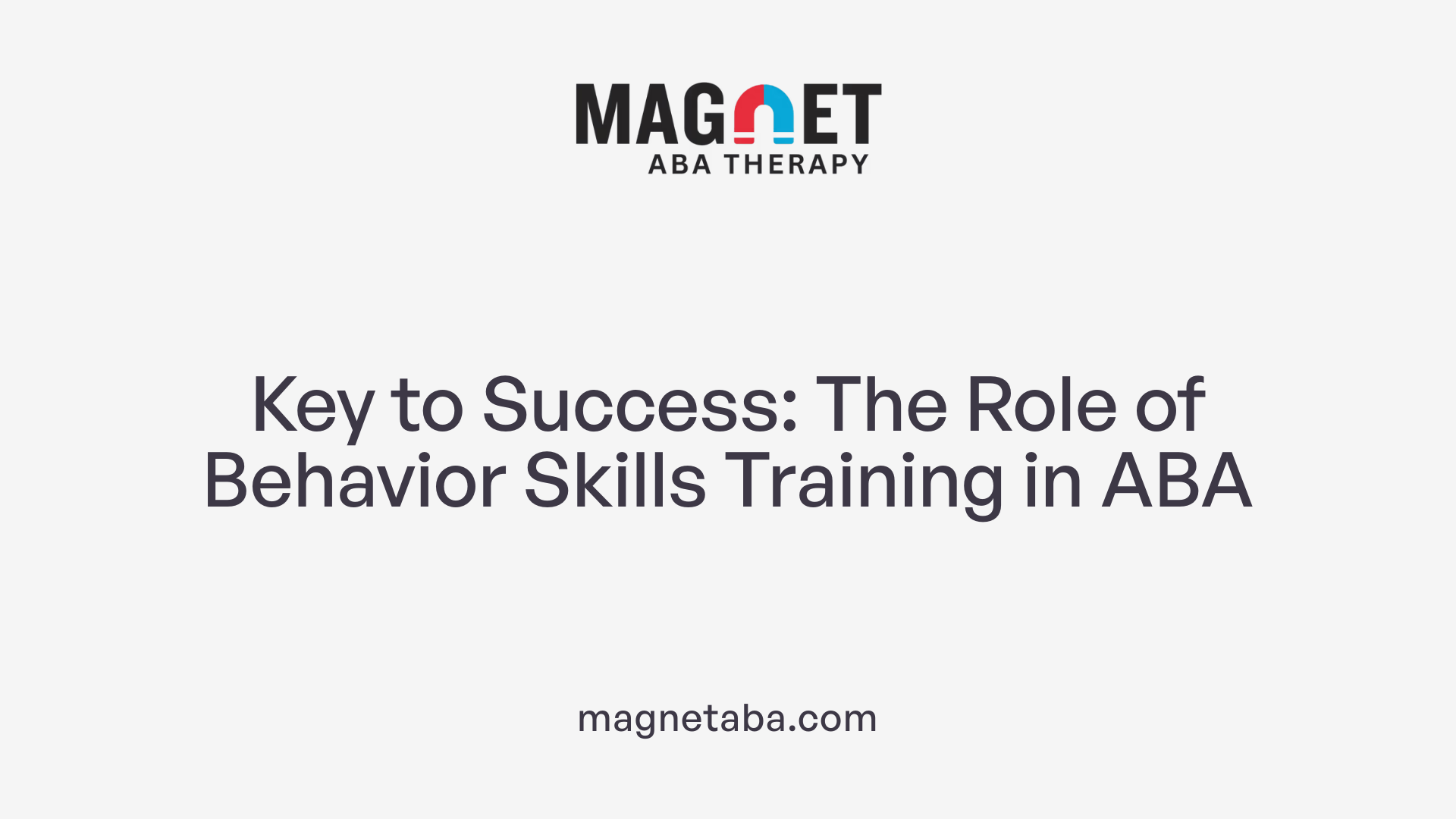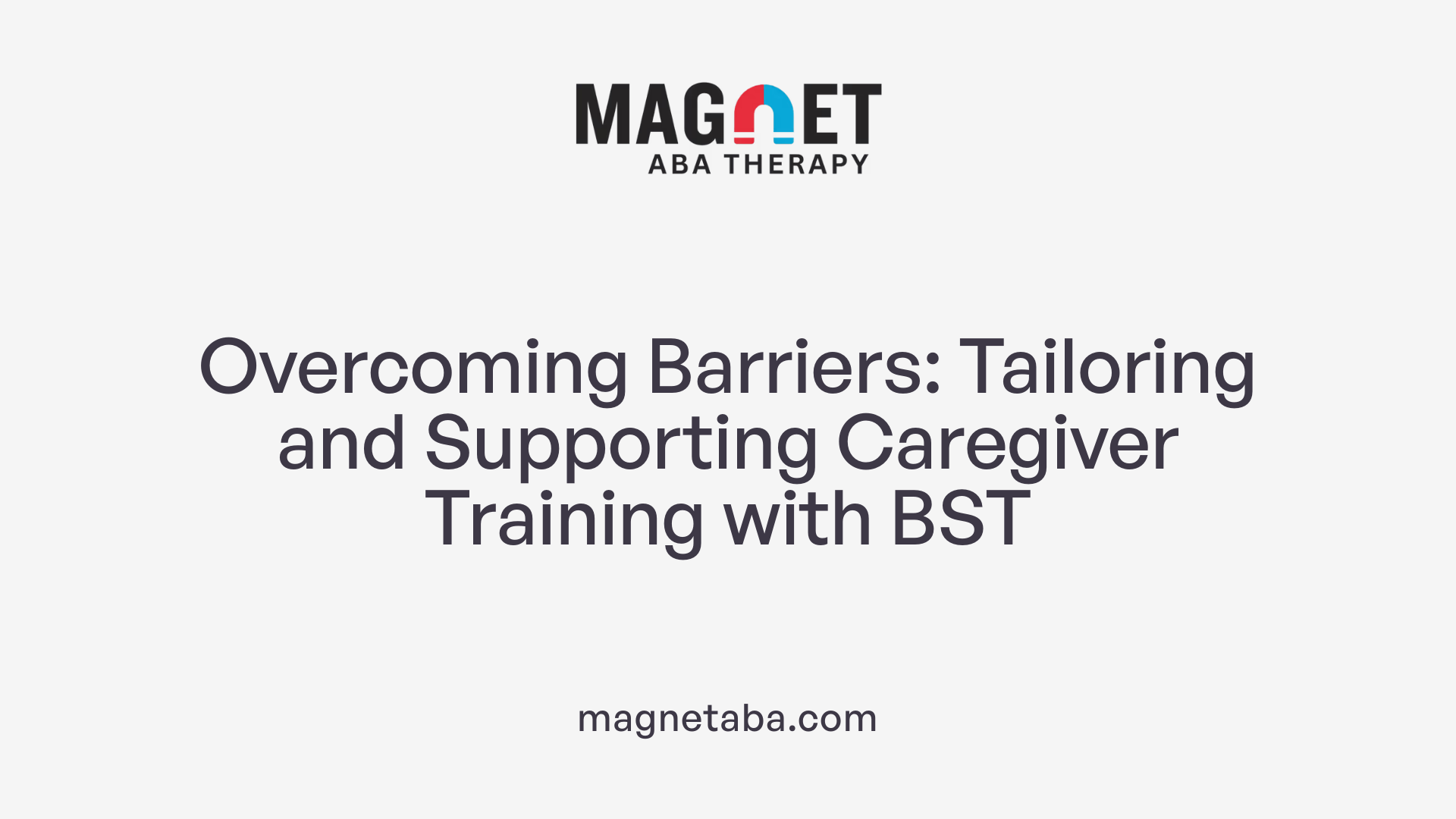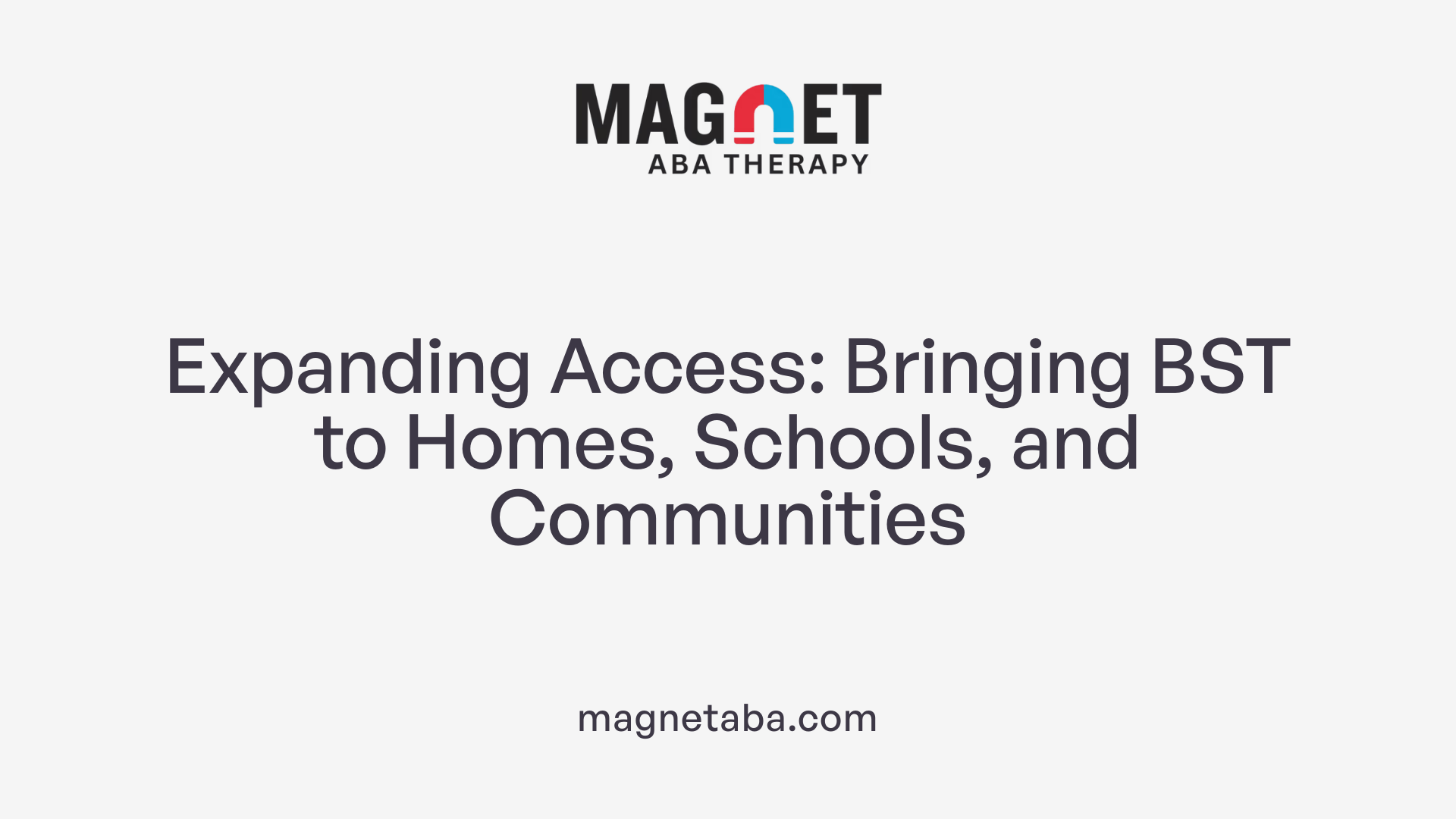Bridging the Gap Between Therapy and Home Care
Applied Behavior Analysis (ABA) therapy has transformed autism treatment by leveraging scientific principles to improve behaviors and skills. Central to ABA's success is the involvement of caregivers, who are pivotal in applying learned techniques consistently throughout daily life. This article explores how Behavior Skills Training (BST), an evidence-based training method within ABA, equips caregivers with the necessary tools to support individuals with autism and other developmental disabilities effectively. By delving into BST's structure, applications, and benefits, we illuminate its vital role in empowering families and enhancing therapeutic outcomes.
Understanding Applied Behavior Analysis (ABA) Therapy
What is Applied Behavior Analysis (ABA) therapy?
Applied Behavior Analysis (ABA) is a therapy grounded in the science of learning and behavior. It aims to understand how behavior functions and how environmental factors influence it. ABA therapy helps increase positive behaviors while reducing harmful actions, especially benefiting individuals with autism.
What is the scientific basis of ABA therapy?
ABA is based on behavioral principles and research that explore how behavior is affected by antecedents (what happens before a behavior), behavior itself, and consequences (what follows the behavior). This ABC model is fundamental in analyzing and modifying behaviors effectively.
What are the key components like the ABC model in ABA?
The core of ABA revolves around the ABCs: Antecedent, Behavior, and Consequence. By identifying triggers (antecedents) and outcomes (consequences), therapists can carefully modify environments to encourage helpful behaviors and discourage negative ones.
In what settings is ABA therapy delivered?
ABA therapy is highly adaptable and can be administered in multiple settings such as homes, schools, or communities. This flexibility ensures that therapy is integrated into daily life, making learning more relevant and practical.
How individualized and intensive is ABA therapy?
A qualified behavior analyst (BCBA) customizes ABA programs to each individual's unique needs, strengths, and interests. These programs are often intensive, particularly when initiated early, involving ongoing assessment and data collection to track progress and adjust goals.
How does positive reinforcement work in ABA?
Positive reinforcement is a primary strategy in ABA therapy. Desired behaviors are rewarded, which encourages individuals to repeat those behaviors. This approach focuses on building skills and promoting independence in a supportive and motivating environment.
The Multifaceted Benefits of ABA Therapy for Autism
How does ABA therapy benefit individuals with autism?
ABA therapy provides comprehensive support tailored to the unique needs of each individual with autism. By using scientifically grounded reinforcement strategies, it effectively increases positive behaviors while decreasing harmful or unhelpful actions. This dual focus promotes overall improved functioning and quality of life.
Improvements in communication and social skills
ABA programs specifically target crucial areas like language and communication development. Techniques such as positive reinforcement encourage the use of speech and alternative communication methods. Social skills training helps individuals learn appropriate interactions, such as making eye contact and engaging in conversations, which are essential for building relationships.
Reduction in harmful behaviors
By analyzing the Antecedent, Behavior, and Consequence (ABC) of actions, ABA therapists design interventions that reduce problem behaviors. These behavioral issues might include aggression or self-injury, and ABA works by modifying environmental factors and teaching replacement behaviors.
Targeted skill development
ABA therapy facilitates improvement in memory, academic skills, attention span, and daily living tasks through individualized plans. Techniques like Behavioral Skills Training (BST) — involving instruction, modeling, rehearsal, and feedback — support learning of specific skills such as asking for help or regulating emotions like calming through deep breaths.
Role of early intervention
Research strongly supports early and intensive ABA intervention. Starting therapy at a young age can lead to more significant progress in communication, socialization, and independence, laying a foundation for lifelong skills.
Empowerment of caregivers and educators
A vital aspect of ABA is training parents, family members, and educators to support consistent practice across daily routines. Caregivers learn to apply behavioral strategies at home or school, enhancing skill generalization and maintenance. This empowerment ensures ongoing support beyond therapy sessions, especially in settings where professional resources may be limited.
Professional Providers of ABA Therapy: Who Are They?

Roles of Board Certified Behavior Analysts (BCBAs)
Board Certified Behavior Analysts, or BCBAs, are the licensed professionals responsible for designing and overseeing ABA therapy programs. They rely on scientific principles to create individualized plans to enhance helpful behaviors and reduce harmful ones in individuals with autism. BCBAs assess progress through continuous data collection and adjust therapies to meet each person's unique needs.
Registered Behavior Technicians
Registered behavior technicians (RBTs) provide direct services under the supervision of BCBAs. They play a vital role in implementing daily therapy sessions, using techniques like positive reinforcement to encourage learning and skill development.
Specialized Autism Service Companies
Many specialized companies focus solely on delivering ABA therapy. These organizations employ qualified BCBAs and RBTs who often provide services in various settings, including homes, schools, and communities, ensuring flexible and accessible support.
Insurance and Medicaid Coverage
Insurance coverage for ABA varies by provider, but many private insurers and Medicaid plans cover ABA therapy when deemed medically necessary. Families are encouraged to communicate with healthcare providers and check ABA directories to navigate access and coverage options.
Collaboration with Families
A critical aspect of ABA therapy is family involvement. Professionals train parents and caregivers to support skill practice during everyday routines, empowering families to reinforce progress consistently.
Ensuring Individualized Plans
ABA providers tailor interventions based on each individual's skills, interests, and challenges. This personalized approach helps improve communication, social skills, memory, academics, and reduces problem behaviors effectively.
| Provider Type | Role Description | Operating Environment |
|---|---|---|
| Board Certified Behavior Analyst (BCBA) | Designs and supervises individualized ABA programs | Clinics, homes, schools, community |
| Registered Behavior Technician (RBT) | Delivers therapy sessions under BCBA supervision | Homes, schools, therapy centers |
| Specialized Autism Service Companies | Employ multiple ABA professionals and provide settings support | Various, including community-based services |
Qualified ABA professionals work together with families and healthcare systems to ensure scientifically sound and effective treatment tailored to each individual’s requirements.
Common Techniques in ABA Therapy: Building Blocks of Behavior Change

What techniques are commonly used in ABA therapy?
ABA therapy uses several effective techniques designed to promote beneficial behaviors and reduce challenges. One of the most widely recognized methods is positive reinforcement, where desirable behaviors are rewarded to encourage their frequent occurrence.
Discrete Trial Training (DTT) is another fundamental approach. It involves breaking down skills into small, manageable steps, presenting repeated opportunities to learn, and providing immediate prompts and reinforcement after each trial.
Shaping and chaining are techniques that teach complex behaviors by gradually reinforcing successive approximations or linking simple behaviors into a sequence, making learning manageable and systematic.
To enhance learning and independence, prompting is used to cue the learner toward the desired behavior, while fading carefully removes these prompts over time to encourage autonomous performance.
Behavior contracts set clear agreements and goals between the learner and therapist or caregiver, providing structure and motivation for behavior change.
Visual supports such as modeling, where the behavior is demonstrated, and tools like picture exchange communication systems (PECS) assist individuals, especially those with autism, in understanding and practicing skills.
Managing difficult behaviors often involves redirection, guiding the individual away from unwanted actions, and extinction strategies, which reduce problematic behaviors by withholding reinforcement.
Together, these techniques form a comprehensive toolkit grounded in scientific research, adaptable to individual needs, and essential for promoting meaningful behavior change within ABA therapy.
Behavior Skills Training (BST): An Integral Part of ABA

What is Behavior Skills Training (BST)?
BST is a systematic and evidence-based method used within Applied Behavior Analysis (ABA) to teach new skills, particularly to individuals with autism. It offers a structured approach that helps learners practice and master skills in a supportive and relaxed setting.
What are the Four Key Components of BST?
BST follows a clear four-step routine:
- Instruction: Clear instructions and explanations about the task are given.
- Modeling: The task is demonstrated to the learner.
- Rehearsal: Learners practice the new skill themselves.
- Feedback: Constructive comments or positive reinforcement are provided to guide improvement.
This cycle is often repeated until the learner reaches mastery.
Which Skill Areas Does BST Target?
BST helps individuals develop a broad range of abilities including:
- Social skills (e.g., making eye contact)
- Communication skills (e.g., asking for help)
- Emotional regulation (e.g., taking deep breaths)
By focusing on these areas, BST supports learners in building practical and meaningful skills for daily life.
How Does BST Help Teach Social and Communication Skills?
The method’s hands-on approach encourages active practice of social interactions and verbal requests in real-life situations. Modeling and rehearsal enable learners to gain confidence and fluency, while feedback ensures they refine their abilities effectively.
Why is BST Important for Emotional Regulation?
BST teaches strategies such as taking deep breaths or using calming techniques through demonstration and practice. This empowers learners to manage their emotions better, reducing problem behaviors and promoting independence.
These elements make Behavior Skills Training a vital, evidence-supported part of ABA therapy that enhances learning and functional outcomes for individuals with autism and developmental disabilities.
Using BST to Train Caregivers: Methodology and Practice
What is the Systematic Four-Step BST Routine?
Behavioral Skills Training (BST) follows a clear, four-step approach designed to teach new skills effectively. This routine includes instruction, modeling, rehearsal, and feedback. Each step builds on the previous one, ensuring that learners not only understand the task but can confidently perform it.
How Does Instruction and Clear Explanation Work?
The training begins with clear instructions. Trainers provide concise descriptions and explanations of the tasks caregivers are expected to learn. This step ensures that caregivers grasp the objectives and understand what successful performance looks like.
Why is Modeling Behaviors Important for Caregivers?
Modeling involves demonstrating the desired behaviors or techniques. Caregivers observe these demonstrations to see exactly how to perform tasks, whether it’s managing challenging behaviors or implementing communication strategies. This visual example helps clarify expectations and serves as a practical guide.
How Do Opportunities for Rehearsal and Practice Help?
After instruction and modeling, caregivers engage in rehearsal — practicing the skills themselves. This hands-on experience is crucial for building confidence and competence, allowing caregivers to try techniques in a safe environment where errors can be corrected.
What Role Do Feedback Mechanisms Play in Mastery?
During rehearsal, caregivers receive feedback, which can be constructive or positive reinforcement. This step is critical for refining skills by highlighting what is done well and what needs improvement, guiding caregivers toward mastery of the techniques.
Why Is Repetition Until Competence Essential?
The BST cycle of instruction, modeling, rehearsal, and feedback is repeated until caregivers demonstrate mastery. This repetition ensures that skills are learned thoroughly, increasing the likelihood that caregivers can apply them effectively in real-life situations with individuals they support.
This structured and evidence-based process empowers family caregivers to support individuals, particularly those with autism or intellectual and developmental disabilities, with confidence and skill. Through BST, caregivers can play an active role in treatment, contributing to better outcomes and fostering greater independence in their loved ones.
Evidence Supporting BST’s Effectiveness with Caregivers

What Did the Systematic Review Find About BST Training for Caregivers?
A systematic review analyzed 17 empirical studies focusing on how Behavioral Skills Training (BST) helps train family caregivers of individuals with intellectual and developmental disabilities (IDDs).
How Does BST Improve Caregiver Skills?
The majority of the studies showed positive outcomes, indicating that caregivers improved in their ability to support their family members effectively through the BST approach. This improvement is largely due to BST's structured method involving instruction, modeling, rehearsal, and feedback.
What Effect Does BST Have on the Behaviors of Individuals with Developmental Disabilities?
BST not only enhances caregiver skills but also positively impacts the behavior of individuals with IDDs, including those with autism spectrum disorder (ASD). Improved caregiver support helps reduce problem behaviors and promotes skill development in these individuals.
What Research Designs Were Used to Study BST's Effectiveness?
Most of the studies employed multiple baseline designs to evaluate BST's impact. Some studies included additional elements such as confederates, booster sessions for skill reinforcement, and peer training to enhance learning and retention.
How Do Booster Sessions and Peer Training Contribute?
Booster sessions help maintain skill levels over time by reinforcing what caregivers have learned, while peer training allows caregivers to learn from each other, further supporting the transfer of skills into daily practice. These components strengthen BST's effectiveness as a training approach.
| Aspect | Details | Contribution to Effectiveness |
|---|---|---|
| Systematic Review Scope | 17 studies on BST for caregivers of individuals with IDDs | Comprehensive evaluation of BST outcomes |
| Caregiver Skill Improvement | Positive outcomes in skills acquisition | Better support for individuals with disabilities |
| Behavior Impact | Behavioral improvements in individuals with IDDs, including ASD | Reduction of problem behaviors |
| Study Designs | Mostly multiple baseline, some with booster and peer training | Rigorous and reliable evaluation methods |
| Supportive Components | Booster sessions, peer training | Enhance skill retention and practical use |
The Impact of BST on Caregivers and Individuals with Developmental Disabilities
How does BST empower family caregivers?
Behavioral Skills Training (BST) plays a vital role in empowering family caregivers by equipping them with practical abilities to support individuals with intellectual and developmental disabilities (IDDs). Through systematic instruction, modeling, rehearsal, and feedback, caregivers gain confidence and competence in implementing ABA strategies effectively at home.
Why is BST especially important where professional support is limited?
In environments with limited access to professional services, BST ensures that caregivers are not left without resources. By developing necessary skills through BST, caregivers can maintain consistent therapeutic practices, bridging gaps caused by scarce professional presence and thereby promoting ongoing progress in individuals with disabilities.
How does BST improve caregivers' ability to implement ABA techniques?
BST enhances caregiver skills by providing clear, structured training that covers the fundamental elements of ABA. Caregivers learn how to apply positive reinforcement and other ABA techniques through repeated practice and corrective feedback, leading to better management of behaviors and more effective skill-building interventions.
How does BST facilitate skill generalization and independence?
One significant benefit of BST is its structured approach that encourages repeated rehearsal in natural settings, which helps individuals generalize learned skills beyond training sessions. This promotes greater independence as learners apply new abilities across various environments and social situations.
In what ways does BST serve individuals across age groups and diagnoses?
BST-trained caregivers support a broad spectrum of individuals, including those with autism spectrum disorder (ASD) and other developmental conditions, spanning different ages. This adaptability makes BST a versatile tool in ABA interventions, tailoring support to diverse needs while maintaining consistency in outcomes.
| Aspect | Description | Impact |
|---|---|---|
| Empowerment of Caregivers | Training caregivers to effectively implement ABA techniques | Increased confidence and caregiving effectiveness |
| Support with Limited Access | Provides necessary skills where professional help is scarce | Continuous therapeutic support |
| Skill Implementation | Focuses on instruction, modeling, rehearsal, feedback | Enhanced execution of ABA strategies |
| Skill Generalization & Independence | Encourages practice in real-life contexts | Promotes autonomy in individuals |
| Broad Reach | Beneficial for various diagnoses and age ranges | Versatile, individualized support |
Challenges and Considerations in Caregiver Training with BST

Need for Ongoing Support and Booster Sessions
Caregiver training using Behavioral Skills Training (BST) often requires more than initial instruction to ensure lasting success. Booster sessions are essential to reinforce skills and prevent skill decay over time. These follow-up trainings help caregivers maintain high-quality implementation of interventions and adjust techniques as needed.
Customization Based on Caregiver and Individual Needs
BST programs must be tailored to fit the unique characteristics of both the caregiver and the individual receiving care. Customization involves adapting instruction styles, rehearsal activities, and feedback approaches to align with caregivers' learning preferences and the specific behavioral goals of the individual with developmental disabilities.
Overcoming Barriers to Professional Support
Many families face limited access to professional guidance due to geographic, financial, or systemic constraints. BST has shown promise in empowering caregivers in these contexts, but challenges remain in ensuring consistent support and resources. Creative solutions, including telehealth and peer-led training, are emerging to bridge these gaps.
Ensuring Fidelity of Skill Implementation
Maintaining the integrity of BST techniques during caregiver-led interventions is critical. Regular assessments and data collection help monitor how accurately caregivers implement skills. Training must emphasize not only the acquisition but also the correct and consistent application of techniques to optimize outcomes.
Importance of Collaboration with Healthcare Providers
Effective communication and collaboration between caregivers and healthcare professionals are vital. Providers can offer guidance, modify treatment goals, and provide additional resources. Coordinated care ensures that caregiver training aligns with broader therapeutic plans and adapts to evolving needs.
This multifaceted approach addresses common challenges in BST caregiver training, fostering improved outcomes for individuals with intellectual and developmental disabilities.
Future Directions: Expanding Access and Integration of BST in Caregiver Support

What is the potential for wider adoption of BST in diverse settings?
Behavior Skills Training (BST) has shown proven benefits in training caregivers of individuals with intellectual and developmental disabilities (IDDs), notably autism spectrum disorder (ASD). Given its structured approach—instruction, modeling, rehearsal, and feedback—BST can be effectively adapted for use beyond traditional clinical environments. Schools, community centers, and home settings stand to benefit from wider BST implementation, allowing caregivers to better support their loved ones across daily routines and varied environments.
How can BST integrate with telehealth and remote training?
The rise of telehealth presents promising avenues for BST delivery. Remote training enables caregivers in underserved or rural areas to access expert instruction without geographical limitations. Telehealth platforms can facilitate live modeling and immediate feedback, preserving BST’s interactive core elements. Such technology-based integration enhances flexibility while ensuring quality caregiver training remains uninterrupted by logistic barriers.
In what ways does BST enhance caregiver confidence and child outcomes?
BST empowers caregivers by equipping them with practical skills through repeated practice and feedback cycles. This structured learning builds caregiver confidence, enabling them to consistently implement behavioral strategies. Increased caregiver competence correlates with improved child outcomes, including better social skills, communication, and reductions in problem behaviors. BST thus reinforces the crucial family role in supporting ongoing developmental progress.
What are the current research trends and innovations in BST?
Recent studies underscore BST’s effectiveness and explore innovations like booster sessions and peer training to improve maintenance of caregiver skills. Researchers are also investigating how to customize BST components for diverse learner profiles and integrate digital tools for data collection and progress monitoring. These advancements aim to optimize BST’s impact and scalability across populations.
What are the policy implications and considerations for insurance coverage?
As evidence supporting BST’s efficacy grows, policy discussions increasingly recognize its role in caregiver training as an essential, evidence-based practice. This influences funding and insurance coverage decisions. Expanding coverage—through Medicaid or private insurers—for BST training programs could alleviate financial barriers and broaden access, making this critical intervention more equitable and sustainable.
| Topic | Description | Benefits/Impact |
|---|---|---|
| Wider Adoption | Use of BST in schools, homes, and communities | Greater caregiver support and skill application |
| Telehealth Integration | Delivery of BST via remote platforms | Accessibility and convenience for families |
| Caregiver Confidence & Child Outcomes | Enhanced skills lead to improved child behaviors and family empowerment | Sustained developmental progress |
| Research & Innovation | Booster sessions, peer training, digital tools | Improved training efficacy and personalization |
| Policy & Insurance | Advocacy for coverage expansion and recognition of BST as evidence-based | Increased affordability and availability |
Empowering Caregivers to Transform Lives
Behavior Skills Training is a cornerstone of applied behavior analysis that extends beyond professional settings to empower family caregivers in supporting individuals with autism and developmental disabilities. Through structured, evidence-based methods, BST equips caregivers with the skills and confidence necessary to implement effective behavioral interventions consistently. This partnership bridges therapeutic expertise and everyday practice, fostering independence, enhancing developmental progress, and improving quality of life. As research continues to validate and refine BST, expanding access and integration into caregiver training promises a future where families are central agents of change, supported by science and community resources alike.
References
- Applied Behavior Analysis (ABA)
- Behavioral Skills Training (BST) in Autism: An approach
- Behavior skills training for family caregivers of people with ...
- The effectiveness of applied behavior analysis program ...
- Applied Behavior Analysis (ABA)
- The Controversy Around ABA
- 6 Benefits of ABA Therapy for Children with Autism
- ABA Techniques: Strategies for Behavior Analysts - GSEP Blog
- ABA Therapy Examples, Definition & Techniques
- Applied Behavior Analysis (ABA)












